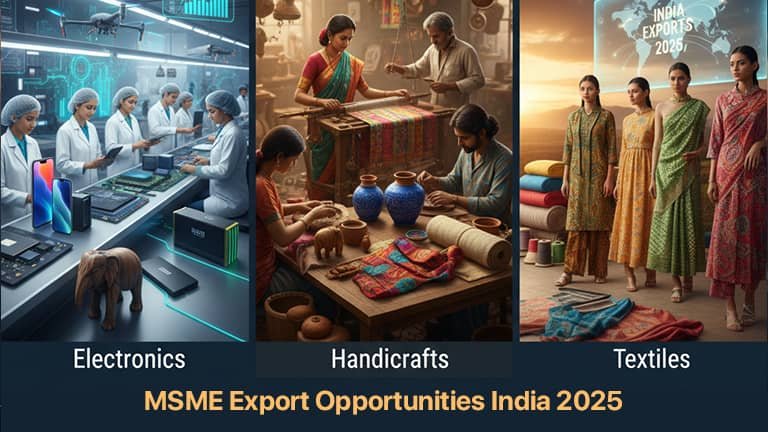
Micro, Small, and Medium Enterprises (MSMEs) are crucial in India’s export ecosystem. They range from traditional handicrafts to advanced electronics, finding strong positions in global markets. With the government focused on Digital India, Make in India, and Atmanirbhar Bharat, the year 2025 offers a wealth of opportunities for MSME exports.
This article examines the export potential in electronics, handicrafts, and textiles. It also looks at trade policy support and how Udyam export benefits can help make India a global manufacturing leader.
The Growing Importance of MSME Exports
India’s MSMEs contribute nearly 45% of the country’s total exports. By 2025, this contribution is expected to grow significantly, driven by government support, shifts in global demand, and stronger supply chain resilience.
Key reasons for this growth are:
- • Increased global interest in Indian handicrafts and textiles.
- • Rising electronics exports under the PLI (Production Linked Incentive) scheme.
- • More digital adoption and new e-commerce marketplaces creating international opportunities.
- • Improved trade policy support providing financial benefits and regulatory ease.
Electronics Export MSME: Powering India’s Tech Dreams
The electronics sector is one of the fastest-growing export areas in India. As global demand for smartphones, semiconductors, and consumer electronics increases, electronics export MSME units are becoming key players.
Opportunities in 2025 include:
- • Consumer Electronics – Smartphones, wearables, and home appliances.
- • Semiconductors & Components – Support from India’s semiconductor mission.
- • EV Components & Batteries – A growing global shift to electric mobility.
- • IT Hardware – Laptops, servers, and networking devices.
Government Support:
- • PLI Scheme for Electronics – Offers financial support for MSMEs producing export-ready electronics.
- • Ease of Customs & Logistics – Faster clearance for export shipments.
- • Digital Platforms – MSMEs can promote their products on global B2B platforms like Amazon Global, Alibaba, and Flipkart Global.
By 2025, India aims to be a global hub for electronics manufacturing, opening many opportunities for MSMEs.
Handicraft Market Overseas: Expanding India’s Cultural Footprint
India’s handicrafts are in high demand worldwide, known for their uniqueness and cultural significance. From wooden carvings in Saharanpur to Kashmiri carpets and blue pottery from Rajasthan, the international handicraft market is thriving.
Key Export Destinations:
- • United States & Europe – Demand for home décor, furniture, and artisanal products.
- • Middle East & Gulf Countries – Handwoven textiles and jewelry.
- • Japan & South Korea – Minimalist craft styles that resonate with cultural aesthetics.
Opportunities in 2025:
- • Increasing demand for sustainable and eco-friendly crafts.
- • A rise in luxury handcrafted home décor in Western markets.
- • Growth in e-commerce exports through platforms like Etsy, Amazon Handmade, and IndiaMart Global.
Trade Policy Support:
- • The government’s Export Promotion Council for Handicrafts (EPCH) organizes international fairs and exhibitions.
- • Financial programs and subsidies assist artisans in modernization.
- • MSMEs benefit from marketing support to globally brand their products.
In this way, 2025 will provide significant growth for the handicraft sector, allowing small artisans to connect directly with global buyers.
Textiles Export: A Traditional Strength with Modern Potential
The textile industry has long been India’s stronghold. With rising global demand for sustainable fabrics, ready-made garments, and technical textiles, Indian MSMEs have vast opportunities ahead.
Major Export Categories:
- • Cotton & Silk Garments – Popular in Europe and the US.
- • Technical Textiles – Used in medical, defense, and automotive sectors.
- • Eco-Friendly Fabrics – Organic cotton and bamboo textiles.
- • Ready-Made Garments (RMG) – India’s largest textile export segment.
Trade Policy Support:
- • RoDTEP (Remission of Duties and Taxes on Exported Products) scheme refunds embedded taxes.
- • Mega Textile Parks (PM MITRA) provide world-class infrastructure to boost textile exports.
- • Interest Equalization Scheme – More affordable export credit for MSMEs.
By 2025, India aims to double its textile exports, giving MSMEs new global opportunities.
Udyam Export Benefits for MSMEs
MSMEs registered under Udyam Aadhar (Udyam Registration) can access several benefits that enhance their export potential.
Access to Export Finance – Priority in obtaining export loans with lower interest rates.
With Udyam export benefits, Indian MSMEs can compete globally and expand their presence across continents.
- • Export Promotion Schemes – Eligibility for subsidies, duty drawbacks, and incentives.
- • Easier Customs Clearances – Udyam-registered MSMEs receive priority in global trade facilitation.
- • Participation in Trade Fairs – Government sponsorships for MSMEs at international exhibitions.
- • Enhanced Credibility – Global buyers trust MSMEs with official recognition through the Udyam certificate.
Challenges MSMEs Need to Overcome
Despite the available opportunities, MSMEs face challenges in exporting:
- • Limited awareness of global trade standards.
- • Restricted access to technology needed for scaling production.
- • High logistics costs compared to global competitors.
- • Compliance with international quality standards.
Nevertheless, trade policy support, digital adoption, and Udyam registration are helping to address these issues.
Future Outlook: MSME Export Opportunities India 2025
Looking forward, the future appears bright:
- • Electronics export MSME units will advance India’s digital manufacturing goals.
- • The handicraft market overseas will grow with eco-conscious consumers.
- • Textile exports will expand with sustainable fabrics and technical advancements.
- • Udyam credit and export benefits will enhance MSME competitiveness abroad.
By taking advantage of government support, global demand, and digital trade platforms, MSMEs can expect a strong increase in exports by 2025.
Conclusion
The year 2025 heralds a new era of export opportunities for MSMEs in India. With growing demand in electronics, handicrafts, and textiles, small businesses can scale globally. Supported by trade policies and the advantages of Udyam export benefits, MSMEs can evolve from local enterprises to global brands.
For MSMEs, the time to act is now. They should register under Udyam, explore export markets, and embrace digital trade platforms to capitalize on India’s export growth in 2025.


